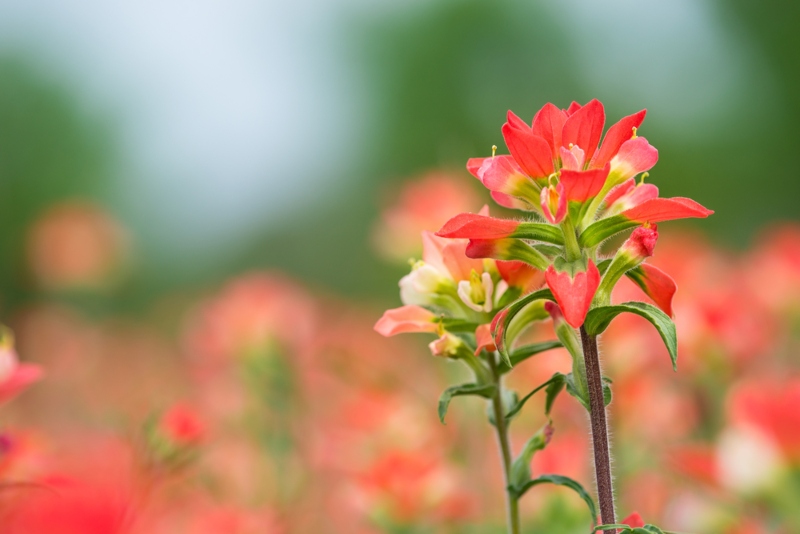Indian Paintbrush (Castilleja Coccinea) creates colorful wildflowers native to prairies and grasslands throughout North and South America.
This plant is also known as Scarlett Painted Cup or Prairie Fire, thanks to its red, orange, and yellow bracts. It is also a biennial. That means that it takes two years to complete a growing cycle, after which the plant will die.
We say bracts instead of blooms because technically, the bright-colored ends to the plants are a type of modified leaves rather than petals. Indian Paintbrush also features seasonal blooms that tend to be red or yellow-tipped, but they’re less showy than the bracts and easily missed.

Indian Paintbrush is a favorite for bees, butterflies, and hummingbirds, making them a favorite in gardens that hope to attract friendly pollinators.
| Botanical Name: | Castilleja Coccinea |
| Common Name(s): | Indian Paintbrush, Scarlett Painted Cup, Painted Cup, Prairie Fire |
| Plant Type: | Biennial |
| Mature Size: | 1-2 feet tall |
| Sun Exposure: | Full sun |
| Water Needs: | Average |
| Soil Type: | Well-draining, moist |
| Soil pH: | 5.1-5.5 |
| Bloom Time: | Spring – early summer |
| Maintenance: | low |
| Flower Color: | red, orange, or yellow |
| Hardiness Zones: | 4-8 USDA |
| Toxicity: | Roots and stems are toxic to humans and pets, flowers are edible |
Indian Paintbrush Care
Indian Paintbrush doesn’t do well in trimmed, manicured gardens. But for a natural, meadow-like aesthetic, it’s a trendy plant. Typically, gardeners and landscape designers grow this plant from seed by sowing in early spring.
From there, the Indian Paintbrush will grow quickly and is technically a hemiparasite. In other words, this plant burrows its roots into the roots of nearby plant systems to get the nutrients it needs. Usually, though, this parasitic activity does not harm the host plant.
Its hemiparasitic nature does mean that it’s best to plant Indian Paintbrush near other grasses native to its natural habitat. Grasses that Indian Paintbrush will do well with include blue-eyed grass, bluebonnet, and beardtongue.
Though we know a lot about the Indian Paintbrush, we don’t know everything. It’s unclear why Indian Paintbrush thrives some years and seems to fail in others, even in the exact location. However, its unpredictable nature is part of this plant’s charm. It’s a true wildflower that cannot be controlled.
Light
Indian Paintbrush thrives in sunny spaces. Shade of any type will inhibit its bright blooms. So, it’s best to plant Indian Paintbrush amongst lower laying plants, such as grasses, which won’t block the sunlight.
Water
The water needs for Indian Paintbrush vary based on where the plant is in its lifecycle. During the first year of life, Indian Paintbrushes need regular watering. You’ll want to keep the soil moist.
In its second year, however, Indian Paintbrushes become hardy and drought-tolerant. They still prefer moist soil but will continue to grow even if conditions become dry.
Temperature/Humidity
Indian Paintbrush thrives in mid-western prairies, meadows, grasslands, and even some mountainous regions. These areas tend to have moderate humidity and temperatures.
Indian Paintbrush can easily survive cold winters, but it doesn’t like intense heat. In desert regions, this plant will suffer greatly.
Soil
Sandy soil that stays moist but provides excellent drainage is ideal for Indian Paintbrush. If the soil becomes soggy, the Indian Paintbrush will have a hard time.
Indian Paintbrush also prefers acidic soil, between 5.1-5.5 pH, but can handle more neutral soils if needed.
Fertilizer
Indian Paintbrush thrives in rough conditions and won’t do well with fertilizer. Adding compost in the spring can help encourage growth, but don’t add any traditional fertilizers to the surrounding soil.
Toxicity
Indian Paintbrush stems and roots are highly toxic to humans and animals. That’s because their roots absorb and concentrate selenium. Selenium toxicity can cause nausea, vomiting, and other unfortunate symptoms.
However, the blooms on the Indian Paintbrush are edible in moderate amounts. Traditionally, Native Americans consumed the flowers as a condiment for other leafy greens. Eaten in that way, the blooms have similar health benefits to garlic.

Potting and Replanting
Indian Paintbrush doesn’t transplant well, so potting and replanting isn’t an option for this plant if you plan to keep it long-term.
Growing From Seed
Growing Indian Paintbrush from seed is simple to do with the right conditions. Simply sow the seeds in early spring or late summer across moist and sandy soil. Ideally, the soil will be between 55 and 65 degrees Fahrenheit.
Indian Paintbrush is slow germinating, and it may take several weeks before you see signs of life, but rest assured it will eventually sprout. Towards the end of its two-year growing cycle, the Indian Paintbrush will reseed itself, making this plant very low maintenance.
Assuming you want your Indian Paintbrush to reseed, though, you must refrain from mowing it down until the plant is dehydrated and the blooms are entirely shriveled. At that point, you can clean up the dead plants, and come spring, you’ll see new Indian Paintbrushes sprouting.





